|
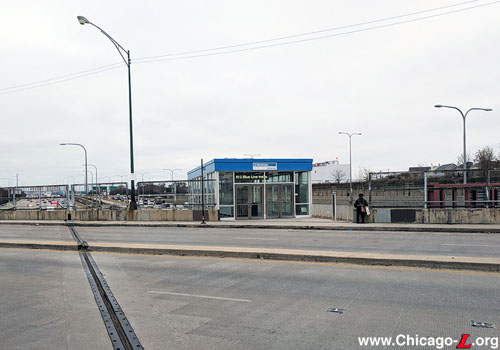
The Montrose station entrance on the south side of Montrose Avenue is seen looking south on November 16, 2017. The south entrance building is larger than its counterpart on the north side of the street, and has doors to enclose it. Both contain stairs that lead to platform level, where the fare controls are located. For a larger view, click here. (Photo by Tony Coppoletta)
|
Montrose
(4400N/4600W)
Montrose Avenue and Knox
Avenue, Irving Park
Service
Notes:

|
Blue Line:
O'Hare
|

|
Owl
Service
|
Quick Facts:
Address: 4600 W. Montrose
Avenue
Established: February 1, 1970
Original Line: West-Northwest Route, Milwaukee branch
Previous Names: none
|
Skip-Stop Type:
|

|
Station
(1970-1995)
|
Rebuilt: 2016 (platform renovation)
Status: In Use
History:
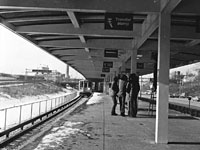
The Montrose station platform is seen on January 30, 1970, as a 2200-series train pulls into the station. The occasion is the dedication of the Kennedy Extension, but the station and line wouldn't open to the public for another two days -- note the person on the ladder on the right performing some last-minute work. For a larger view, click here. (CTA Photo) |
The extension of the Milwaukee Line of the West-Northwest Route (the forerunner of today's Blue Line) reached its new terminal at Jefferson Park via a new subway and
the median of the Kennedy Expressway. After running in subway under
Milwaukee and Kimball avenues, the line crosses under the eastbound
lanes of the John F. Kennedy Expressway at School Street (3300N),
ascends to the surface and continues northwest another four miles in
the median of the Kennedy Expressway to Jefferson
Park (5400N). Built concurrently with the Dan Ryan Line -- and
together known as the Kennedy-Dan Ryan ("KDR") project -- the Kennedy
Extension incorporated several new design features that were
considered revolutionary or at least very modern for the time.
The design of the six stations of the Kennedy
Extension was carried
out by Skidmore, Owings & Merrill under the direction of Myron
Goldsmith, who developed a modern, functional form in the late
International style popular at the time. Improved visibility and
security, ease of cleaning and more comfortable working conditions
for CTA employee were design
goals. Skidmore took the KDR project in a unique direction, designing
all aspects of the new lines to harmonize in both shapes and
materials. The shape of everything, from the buildings to the agents'
booths, to the trash cans, followed together into a seamless design
philosophy, which perfectly captured the boxy, purely functional
International Modern style for which Skidmore is so well known.
The formal and functional criteria were expressed in several
ways: open, uncluttered, brightly lit interior spaces; durability,
safety, maximum efficiency of movement; lightness and purity of
structure. All windbreaks, dividers, and ticket booths were stainless
steel.
The International
style median stations were constructed of white steel and glass providing
maximum visibility from adjacent streets and highways boxy. In terms
of interior arrangement and design for the passenger, Skidmore
generally followed the edict of modernist pioneer Mies van der Rohe
that‚ "less is more." Except for at a few locations, there were
no concessions provided for passengers. Air conditioning and a
compact washroom with a toilet were provided in the agents' booths.
Restrooms were for employees only, though payphones were provided.
Stainless steel turnstiles, now an industry standard, were first used
here. The amenities and traffic circulation fit with the
architectural design of the station: efficient but purely functional.
Stations were designed with wide walkways and no blind corners, with
turnstiles and agents booths arranged for maximum queuing and
circulation effectiveness. The Dan
Ryan and Kennedy stations were also set up to allow Pay On Train
operation, though without all of the complicated gates and
rearrangement built into the Congress stations. The boarding platforms were long enough to accommodate 8-car
trains.
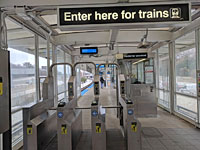
The Skidmore-designed
Montrose station fare control area seen on November 16, 2017, very much as it was originally built. Note how
everything is harmoniously rectilinear in design, thanks to
Skidmore's holistic approach. For a larger view, click here. (Photo by Tony Coppoletta) |
Montrose is one of four median stations, which were the
centerpieces of Skidmore's design for the KDR project. The station features entrances on the both sides of Montrose Avenue, each a rectilinear building of white-painted steel frame with full-height glass curtain walls located at street level and cantilevered over the tracks below. The buildings are small, with each enclosing a stairway and escalator to to platform level and with space for passengers transferring to buses to wait inside. The stairs and escalator from the north station house lead directly to the fare controls located inside an enclosure at the south end of the platform. The vertical access from south station house leads down to a platform-level walkway between the tracks that leads under the roadway overpass to the fare control area. The stainless steel ticket agent booth and turnstiles were at platform level; the booth is now used by a Customer Assistant, and the original turnstiles were replaced with Cubic-manufactured
electronic farecard equipment -- turnstiles and vending machines -- in the mid-1990s.
Typical of the Skidmore-designed KDR stations, the Montrose platform featured large-aggregate terrazzo flooring and a canopy supported by a single row of square support posts. The canopy, which
extends beyond the center line of the tracks, has a white-painted steel
frame with rows of translucent domes. Self-service infrared radiant heaters are located at
windbreaks on the platforms. The platform is curved, which was not ideal but workable because conductors worked the doors on the train and were positioned in the center of the train where they visibility from the midpoint of the curve. After conductors were withdrawn from trains in the 1990s, cameras and monitors were set up to assist the Operator with the view down the train when closing the side doors.
In spring 2008, the CTA replaced the original KDR-style
signage with Green Line
Graphic Standard station name signs and symbol signs. The work
included removal of the 1970-vintage red (indicating its former
status as a "A" station in skip-stop operation) column and station name signs on the platform, as well as
the installation of new entrance signs on the front fascias of both street-level station houses.
Your New Blue: Station Improvements
On December 5, 2013, Mayor Rahm Emanuel and Governor Pat Quinn announced a comprehensive improvement plan for the Blue Line O'Hare Branch (including the northern portion of the Dearborn Subway), an overhaul that will provide faster travel times and updated stations while creating more than 1,300 jobs.
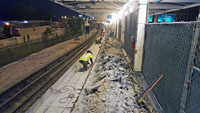
Crews have demolished the deteriorating platform edge and original platform topping to replace both, and are preparing to set new rebar for the platform edge in the early morning hours of May 22, 2016. For a larger view, click here. (CTA photo) |
The $492 million plan, called Your New Blue, includes several track and station improvement projects along a 12.5-mile stretch of the Blue Line between the Grand and Cumberland stations, as well as upgrades to the signal system between the Jefferson Park and O'Hare stations. The overall Your New Blue program, beginning construction in 2014 and planned to last four years, is a package of several discrete projects ranging from station improvements to track renewal, signal replacement, traction power upgrades, and subway tunnel water mitigation efforts.
Montrose is one of 13 stations planned to receive improvements under the program, with Montrose to receive improvements more modest in scope. Addison, Irving Park, Montrose, Harlem and Cumberland stations were packaged as a group for design and construction, and all five stations had significant deterioration to their island platform decks and particularly the edges cantilevered toward the tracks. To address this, the stations received new platform edge and topping replacement. In addition, walkway railings and platform furniture such as benches, windbreaks and trash cans was rehabilitated or replaced as needed. Light fixtures were provided with new lamps and ballasts, and all five stations were repainted.
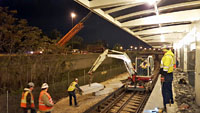
Work is underway at Montrose station to renovate the platform, lifting new precast concrete
platform deck panels into place Montrose early on the morning of May 21, 2016. For a larger view, click here. (CTA photo) |
On March 11, 2015, the Chicago Transit Board approved the award of a $25.6 million contract to F.H. Paschen and S.N. Nielsen for the renovation of five O'Hare branch stations, including Addison. Design work began in spring 2015, with rehabilitation work at the Addison, Irving Park, Montrose, Harlem and Cumberland stations to begin in fall 2015. All stations remained open during the construction period, except for a small number of weekend-only closures at Addison and Montrose. In addition, in order to carry out the platform renewal work, each station's platform was closed half at a time, longitudinally down the middle. Trains bypassed the side of the platform being worked on, which was barricaded from passenger access to allow the deck topping to be removed and replaced. Each half-closure and bypass period lasted three weeks (except at Harlem and Cumberland, which were shorter), during which passengers had to "back-ride" (riding to the next stop, exiting and boarding a train back in the opposite direction) or use alternate existing bus or rail services. While inconvenient, the partial station closures allowed the CTA to keep the stations open for customers at all times during platform work.
Montrose station's platform renewal began with the O'Hare-bound side of the platform, which closed from the evening of April 26 through, May 17, followed by the Forest Park-bound side from the evening of May 17 to June 7.
Montrose required two weekend closures, because there was no practical way to replace the platform decking in the fare control area and maintain and safe pathway through the work area for passengers. A bus shuttle was operated between Montrose and Irving Park stations during these closures, the first of which occurred on April 29-May 2; the second closure occurred on June 3-6. In addition, the south entrance/exit to the Montrose station temporarily closed from 9pm, Tuesday, May 17 to Tuesday, June 7, requiring passengers to use the north entrance/exit located across the street, on the north side of Montrose Avenue.
Renovation work at Montrose was substantially completed by late Fall 2016.
Station Artwork
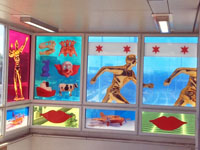
A series of art glass panels titled Windy City Odyssey, seen in the Montrose station north entrance soon after installation, depicts various trinkets and curios representing aspects of the city. The red lips represent the iconic sign for the Magikist rug cleaning company, which used to stand near the station, by the side of the Kennedy Expressway at Montrose. For a larger view, click here. (Photo courtesy of the CTA) |
In late summer 2020, new artwork was installed at the Montrose Blue Line as part of CTA's commitment to feature public art across CTA bus and rail facilities throughout the City of Chicago. CTA's collection of public art includes more than 70 permanent works of art across all eight rail lines and multiple bus facilities.
Inspired by the world of colorful toys and vintage Americana, Chicago-based artist Chris Cosnowski was selected by CTA to create a unique piece of artwork for the Montrose Blue Line station, which is featured on the station entrance on the north side of Montrose Avenue.
The artwork, known as Windy City Odyssey, is a series of art glass panels depicting various toys and trophies representing different aspects of Chicago's cultural significance, history and character. The bodybuilder trophy, for example, recalls Chicago's nickname as "The City of Big Shoulders", while the toy cow represents Mrs. O'Leary's cow and The Great Chicago Fire. The artist uses the symbol of the penny to illustrate Illinois' greatest political figure and a red-and-white tugboat to signify our hard-working city located on both Lake Michigan and the Chicago River.
The collective value of the the installation and another at Diversey Brown Line installed about the same time was $200,000 and was paid for using Federal Transit Enhancement funds provided by the Federal Transit Administration (FTA).
All Stations Accessibility Program (ASAP)
In July 2018, the CTA released its first plan to make the entire system accessible to people with disabilities over the next 20 years. The All Stations Accessibility Program (ASAP) will cost about $2.1 billion, according to CTA, but the program was not funded at the time of the announcement. Rather, CTA formulated and announced the plan to begin the effort to secure funding by building support and increasing awareness of accessibility needs.1
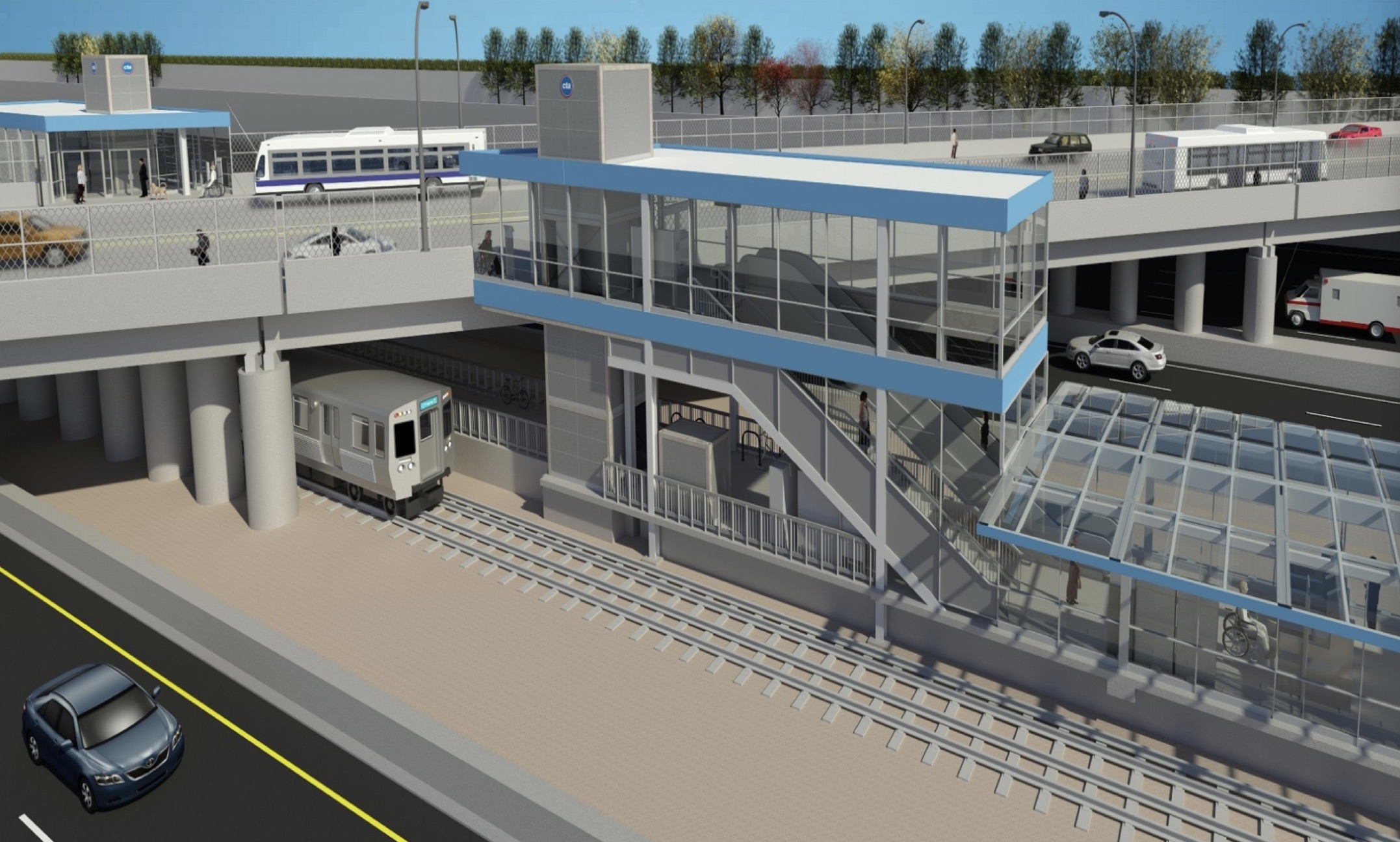
Artist's rendering of the conceptual design for the changes to Montrose proposed in the ASAP Strategic Plan. For a larger view, click here. (Rendering courtesy of CTA) |
Given the magnitude of this endeavor, project work was proposed to be performed in four phases over the 20-year period. To help prioritize the non-accessible stations, scores were assessed to each location based on needs and the complexity of work to be performed. The criteria used in determining the needs score is similar to what was used in previous CTA accessibility analyses (i.e. the 2012 Infrastructure Accessibility Task Force [IATF] Plan) such as ridership and gaps between accessible stations. In general, stations with higher needs and lower complexity scores were prioritized for near-term plans. Highly complex stations that require more time for planning, design, construction, agency coordination and community input are part of long-term project plans.2
Phase one of the ASAP plan puts elevators in eight stations: Austin on the Green Line, Montrose and California on the Blue Line, State/Lake on the Loop, and Lawrence, Argyle, Berwyn and Bryn Mawr on the Red Line.3 The State/Lake project has been discussed on and off since the 1980s, and is an effort managed by the Chicago Department of Transportation (CDOT). The four Red Line stations are being rebuilt as part of the larger $2.1 billion Red & Purple Modernization Program, Phase One.
In the ASAP plan, the existing Montrose station entrances and platform structures are proposed to be retained but renovated and modified. Two elevators (one on each side of Montrose Avenue) are proposed at the existing north and south entrances/exits. Placement of the elevators at these locations minimizes the distance to access the station relative to the existing bus stops and eliminates the need to cross Montrose Avenue, which has heavy traffic, for accessible routes from bus stops. The 'up' escalator at the south entrance is proposed to be removed to accommodate the elevator there; the escalator at the north entrance is proposed to remain. Both proposed elevators will be located on the unpaid side of the platform-level fare controls.4
Cost estimates for the three ASAP Phase One stations that were not part of RPM or CDOT's program were based on the proposed designs at a 10 percent completion level.5 When escalated to the Year-of-Expenditure (YOE), calculated to the midpoint of construction, the total unfunded cost of ASAP Phase One is $140.3 Million. The YOE cost estimate accounts for annual inflation, which makes the same project more expensive to implement in future years. The estimated cost for the ASAP improvements at Montrose is $14.3 million in 2017 dollars, or $16.1 million when escalated to the YOE.6
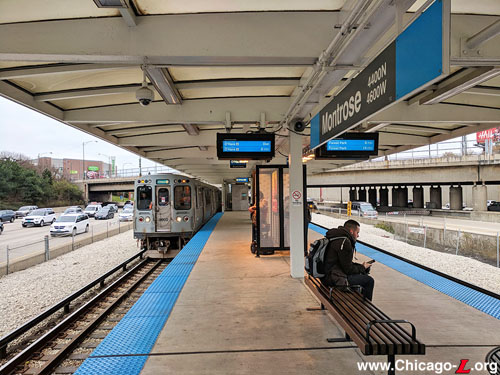
An O'Hare-bound Blue Line train enters the Montrose platform,
looking southeast on November 16, 2017. The original
stainless steel windbreaks were replaced with new
shelters using modular parts formerly used for bus stop
shelters during spring 2008. The station still has its
original plexiglas skylight "bubbles"
in the Skidmore-designed steel canopy. The platform was renovated with new platform decking, lighting, painting, signage and other improvements in 2016. For a larger view,
click here. (Photo by Tony Coppoletta) |

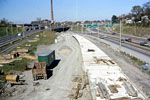
|
montrose01.jpg (220k)
Construction of the Montrose station has begun in this October 19, 1968 view, this view looking north from the Montrose Avenue overpass showing the platform structure beginning to take shape. Construction of the trackbed has yet to begin. In less than a year and a half, the station and tracks would be finished and open for service. Note the original Kennedy Expressway, only a few years old, and the designation of the expressway northwest of the junction here on the overhead sign as IL-194, not changing to Interstate 90 until a decade later. (Photo by
David Wilson) |
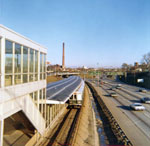
|
montrose03.jpg (163k)
2000-series cars, in their original paint scheme, bring up the rear of a Congress-Milwaukee train stopping at Montrose on its way to Jefferson Park, looking north from the Montrose overpass on March 21, 1973. (Photo from the Scott Greig Collection) |
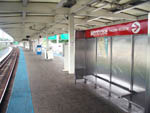
|
montrose04.jpg (202k)
The Montrose station platform is seen looking north on May 14, 2005. At this tome, the station still retained many of its original finished. Besides the original large-aggregate terrazzo flooring and a white-painted steel canopy with rows of translucent domes, the stainless steel windbreak with integrated bench and original-generation KDR-type station name sign indicative of the aesthetics Skidmore brought to the project. (Photo by
Graham Garfield) |
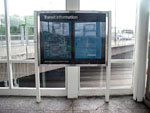
|
montrose05.jpg (206k)
One of Montrose's original KDR-style Transit Information Panels, seen here on May 14, 2005, survived into the early 2010s. These panels consisted two of maps -- a rail system map and a bus connections map (akin to what would now be called a "spider map") screened onto a plywood panel. Although the maps had been updated since their 1970 installation, the rail map's last updated in 1983. The paint on the graphics was badly alligatoring and cracking. The panel has since been modified to house two frames used by current CTA map posters. (Photo by
Graham Garfield) |
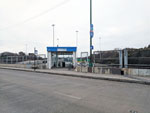
|
montrose07.jpg (191k)
The Montrose station entrance on the north side of the street is seen looking northwest on November 16, 2017. The small headhouse encloses a stairway and escalator between the street and the platform-level fare controls. The rectilinear form is typical of the International Style stations Skidmore designed for the line. The entrance was repainted during Your New Blue program improvements in 2016. (Photo by
Tony Coppoletta) |
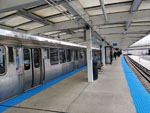
|
montrose10.jpg (240k)
A 2600-series Blue Line train bound for O'Hare stops at Montrose station on November 16, 2017. The station received a new platform deck, tactile edging, painting, lighting and other improvements in 2016. (Photo by
Tony Coppoletta) |

|
montrose11.jpg (198k)
Crews work to demolish the deteriorating platform edge for replacement during the night of April 30, 2016. (CTA photo) |
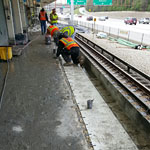
|
montrose12.jpg (369k)
Contract construction workers prepare the base support structure of the platform edge -- already cleared of the original decking -- for a new rebar-reinforced concrete platform edge and deck to the installed on the northbound side at Montrose, on May 1, 2016. (CTA photo) |

|
montrose13.jpg (289k)
Workers on a scaffold prep and prime the Montrose platform steel canopy prior to repainting it, working over the tracks during a weekend single-track on May 1, 2016. (CTA photo) |

|
montrose14.jpg (254k)
The original deck topping on the platform-level walkway connecting the entrance on the south side of Montrose, under the roadway overpass, to the fare control area has been broken up in advance of removal for replacement, looking southeast on May 21, 2016. (CTA photo) |

|
montrose15.jpg (143k)
A new concrete deck is in place on the platform-level walkway to the south side of Montrose Avenue, looking southeast between the stair and escalator up to the north side of the street in late May 2016. (CTA photo) |

|

|
Notes:
1. Wisniewski, Mary. "CTA plans for accessible stations, though funds are not available." Chicago Tribune, July 19, 2018.
2. Chicago Transit Authority. "All Stations Accessiblity Program (ASAP)" flyer. July 2018.
3. Wisniewski, ibid.
4. Chicago Transit Authority. All Stations Accessiblity Program (ASAP) Strategic Plan, July 2018, pp. 40-41.
5. Ibid, p. 83.
6. Ibid, p. 85.





















